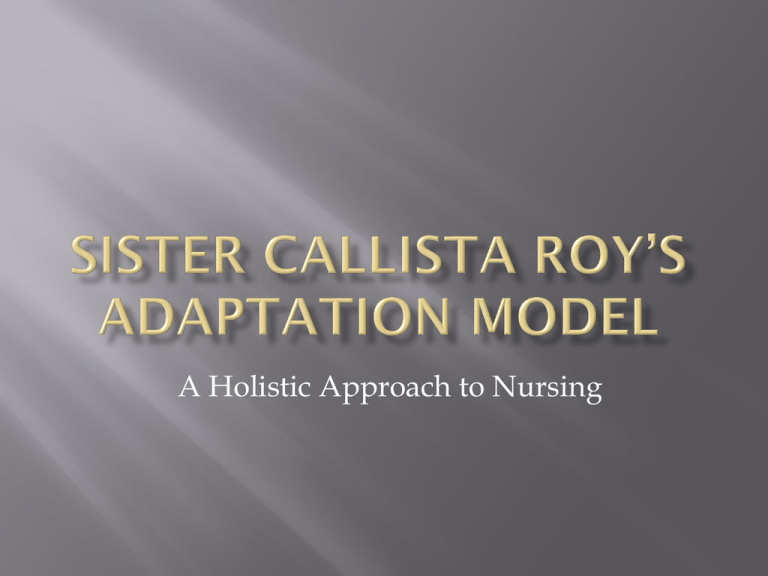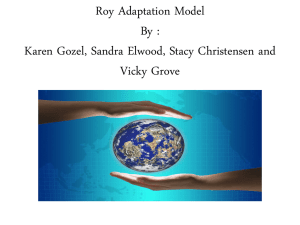Sister Callista Roy*s Adaptation Model
advertisement

A Holistic Approach to Nursing In 1970 while developing curriculum for nursing students Sister Callista Roy presented a conceptual framework of her model. In 1976 the first edition of, “Introduction to Nursing: An Adaptation Model” appeared and was followed by a second edition in 1984. She once again updated her writing in 1999 (Chitty & Black, 2011, p. 313). 1. The person is viewed as a holistic system. 2. The internal and external stimuli of the environment affects a persons behavior. 3. Health and wellness are affected by a persons ability to adapt. 4. The nurse manipulates the environment to assist the person/patient to adapt. (Weiland, 2010, p. 282) Humans are: Physiological- requiring maintenance of basic human needs. Self-conceptual-requiring maintenance of the mind. Self-functional- adapting to changes, personal roles and maintaining self perception. Interdependent- relationship with others, finding a balance of independence and interdependence. (Nursing Theory, 2011) Humans are bio-psycho-social beings. Humans live in a ever changing environment. Humans must cope with the changing environment. Health and illness are inevitable. Humans must adapt positively to the environment. (Nursing Theory, 2011) Environment Concept Refers to all internal and external conditions, circumstances and influences affecting the person and his or her development and behavior. According to this model, when one is subjected to stress their coping mechanisms are ineffective in processing the adaption of environmental stimuli. Stimuli can be focal (immediately confronts the adaptive system), contextual (where the environmental factor has caused a certain situation), or residual (environmental factors cannot be defined)(Mastal, 1980). Health Concept Process of becoming an integrated and whole person and a process of being. There is a distinct difference between the model and medicine. Medicine is treatment of the disease while the adaptation covers the wider issues growth, adaptation, and survival. Nursing Involves the promotion of adaptation concepts during health and illness from ineffective or inadequate response to increase health and wellness. Focuses on the person and medicine focuses on biological systems and the patient’s disease. Uses four modes: physiological, self-concept, role function and inter-dependence. (St. Rosemary Education Institution, 2012) Person and Relating persons A system that adapts to its environment. Three modes in the adaptation: Self-concept-- need for psychic integrity and perception of worth. Role function-- need for social integrity and interaction with others. Physiological mode-- relates to the way individuals play their functions in accordance with their positions. (Mastal & Hammond, 1980) The adaptation model views the person as a holistic system (psychological and biological being). External environment has an impact on the patient’s well being due to interacting with the environment all the time. The nurse must consider external stressors and change interventions in the nursing process for adaption. Roy’s adaptation model was built for nursing and has use in nursing practice, education, and research (“Application of Roy’s Adaptation Model (RAM),” 2012). The model encompasses the four global concepts of human being, environment, health and nursing. The model can be used in a variety of settings with the patient and their environment as the focus for care. This model has been used in hospitals in all settings to test the likelihood of improved patient outcomes. The results gathered from patients and subjects were achieved desired patient outcomes with providing a structure and focus from the nursing model (Weiss, Hastings, & Holy, et al., 1994). Prepared by: Kim Gurizzian Michelle Johnston Stephanie Lombardi Author. (2012). Sister Callista Roy. Nursing Theory. Retrieved from http://nursingtheory.org/nursing-theories/Sister-Callista-Roy.php Chitty, K. K., & Black, B. P. (2011). Professional nursing: Concepts & challenges (6th e.d). Maryland Heights: MO, Saunders. Mastal, M., & Hammond, H. (1980). Analysis of the Roy adaptation model: A contribution to holistic nursing. Advances in Nursing Science, (2)4, 71-82. Nursing theories: A companion to nursing theories and models. (2012). Application of Roy’s adaptation model (RAM). Retrieved from http://currentnursing.com/nursing_theory/application_Roy's_adaptation_model.html St. Rosemary Education Institution. (2012). “The Roy Adaptation Model, Environment/Society, Nursing.” Retrieved on Friday October 2012 from http://schoolworkhelper.net/the-roy-adaptation-model-health-environmentsocietynursing/ Weiland, S. A. (2010). Integrating spirituality in critical care: An APN perspective using Roy’s adaptation model. Critical Care Nursing, 33(30), p282-291. Weiss, M. E., Hastings, W. J., Holly, D. C., et al. (1994). Using Roy Adaptation Model in practice: Nurses perspectives. Nursing Science Quarterly(7), p. 80-86. doi: 10.1177/089431849400700208 You are working in a sub acute rehab facility caring for a 75 year old male who is post stroke with left side hemiplegia. The patient is reportedly “upset” and it has been documented that he frequently yells at the staff while they are assisting him with his ADL’s. The patient’s spouse is at bedside during the day and leaves for home after supper to shower and rest. On this particular day the patient is observed yelling at his spouse and caregivers saying “just leave me alone, you don’t know what you’re doing.” The patient’s wife is now tearful and leaves for home. As the patient’s nurse, how would you use Roy’s Adaptation Model to care for this patient and his family?









